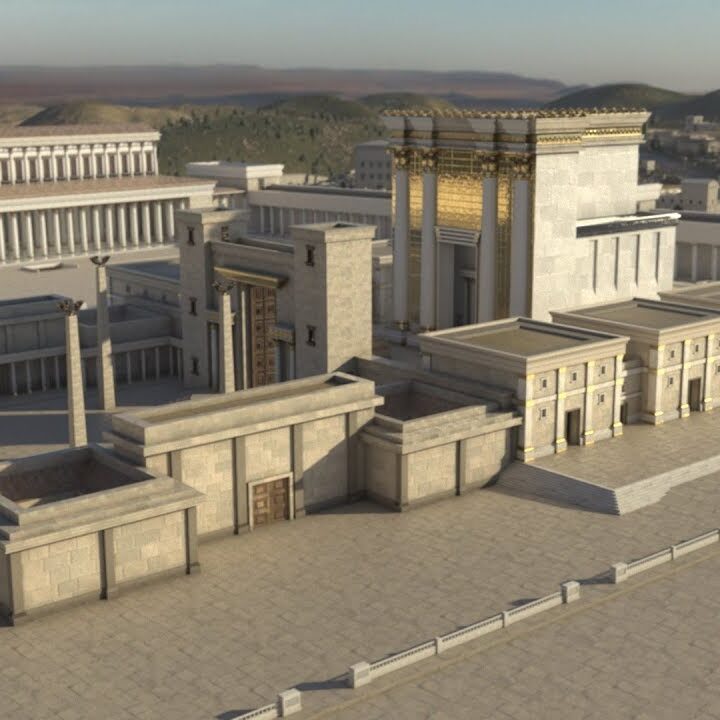
The Temple in Jerusalem plays an important role in the New Testament. It was the center of the Jewish faith and consequently, was the center of many of Jesus’s teachings. Not only were many of Jesus’s teachings given at the temple, but his sermons were full of temple references, imagery and symbolism.
1) It was called the “Second Temple” and “Herod’s Temple
It was the “second temple” because the first temple, which had been built by Solomon, was completely destroyed by the Babylonians in 586 BC when they overthrew the kingdom of Judah and took the remaining Jews captive (this story is told in the books of 2 Kings, Jeremiah, and Lamentations in the Old Testament). After almost 60 years in captivity the Emperor Cyrus allowed the Jews to return to Jerusalem and rebuild the temple (this story is told in the books 2nd Chronicles, Ezra and Nehemiah in the Old Testament). The Jews, led by a man named Zerubbabel, rebuilt Jerusalem’s wall and began laying the foundations for the rebuilding the temple. For this reason the second temple was also sometimes called “Zerubbabel’s Temple” because he was the one who began it’s construction. This second temple was rededicated by the Jews in 515 BC.
Herod the great, was the Roman king of Judea from 37 BC–AD 4 . He was called “the great” not because he was a great king but because of the monumental and “great” building projects he commissioned in Judea during his rule. He developed a water supply system for Jerusalem and built impressive fortresses and palaces in Masada and Herodium. Yet his most ambitious project was the rebuilding and massive expansion of the Jewish temple in Jerusalem.
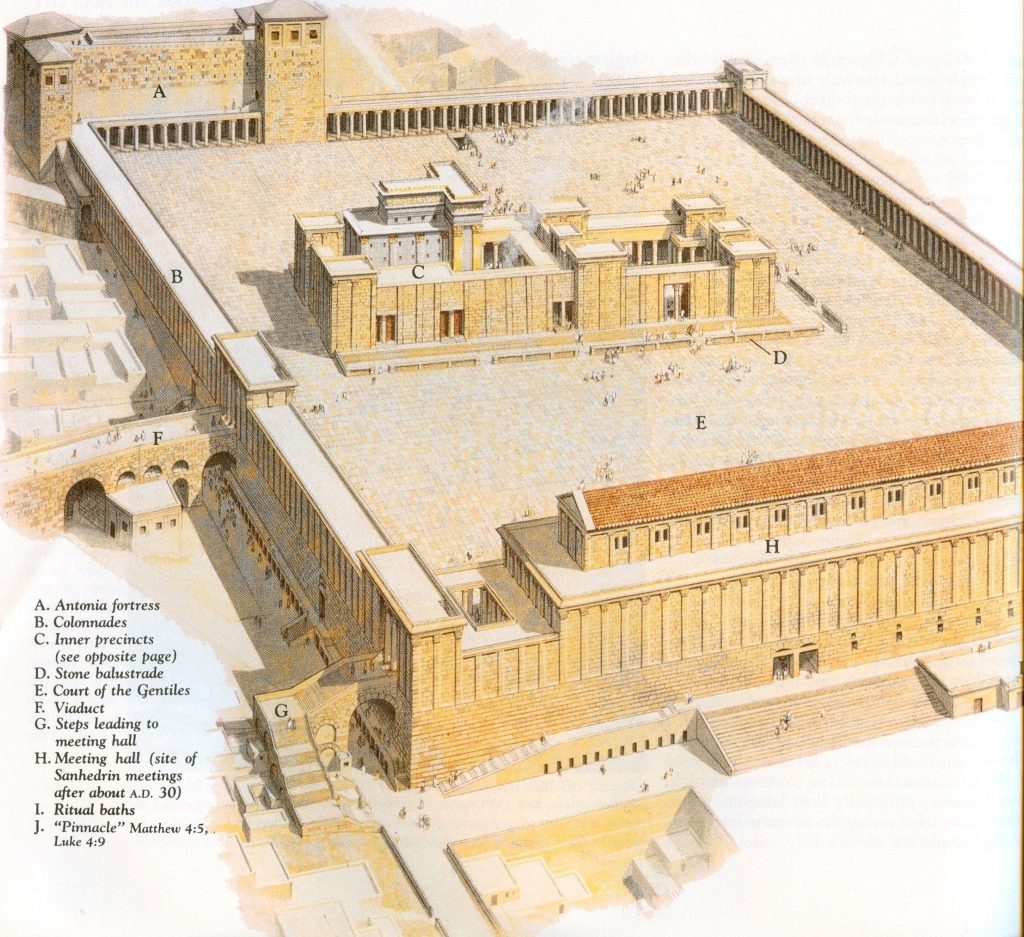
By Herod’s time the second temple was nearly 500 years old and was not in great shape, having been ransacked by many different invaders over the centuries. The Jewish historian Josephus wrote that Herod wanted to immortalize his name through his building projects and that these projects were paid for by extracting heavy taxes. This made Herod an unpopular ruler, and it is probable that his focus on rebuilding and expanding the Jewish temple was an attempt to appease and mollify the Jews populace. Herod poured enormous amounts of money into the building of the temple. He hired architects from Greece, Rome and Egypt to design it, but the actual construction was done by the Jewish priests as part of their priestly duties.
Before Herod began his building project the temple was relatively small, consisting of only the sanctuary building and the outer court on top of Mount Moriah. Herod expanded the temple to fill the entire mountain, turning it into a giant rectangular platform the length of ten football fields, with enormous retaining walls on all sides. It was no longer just the temple, but an entire Temple complex known as the “temple mount”.
This temple mount included the actual temple with it’s holy of hollies in the center, outer courtyards, numerous gates with sweeping staircases, huge walls and even a Roman Fortress called the Antonia Fortress. It was one of the most magnificent buildings of its day and quickly became the came the center of Jewish identity and worship. No one knows exactly how long it took to build, but it likely that parts of it were still under construction during Jesus time.
2) It was Missing Some Important Parts
When the Jews built the second temple they tried their best to rebuild it after the same manner that the first temple, Solomon’s Temple, was built. Yet, there were a few things that were destroyed or lost during the destruction of the first temple which could not be replaced. The Latter-Day Saint Bible Dictionary explains,
The Jews reckoned the temple of Zerubbabel [the second temple] to be in five points inferior to the temple of Solomon: in the absence of (1) the Ark of the Covenant (lost or burned at the destruction of Jerusalem and never renewed); (2) the Shechinah or manifestation of the glory of the Lord; (3) the Urim and the Thummim (Ezra 2:63); (4) the holy fire upon the altar; (5) the spirit of prophecy.
The Ark of the Covenant, with the Mercy Seat, was the center of the Jewish temple. It was literally in the center, within the Holy of Hollies and was believed to be the literal dwelling place of God. When the Ark was within the temple the Shechinah, a word which means “dwelling place”, was present in the temple. God was there. Without the Ark, the Shechinah, the dwelling place of God, and the manifestations of His power was lost. The temple in Jesus’s day was physically a magnificent building but was spiritually empty.
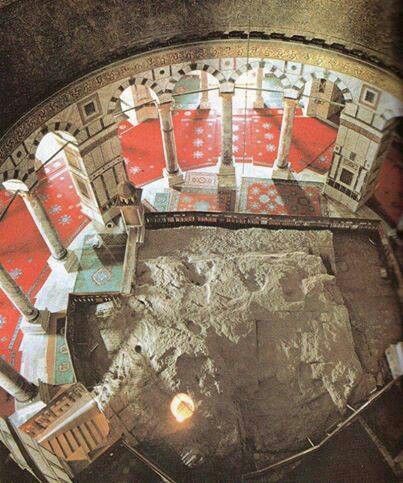
Interestingly, in Jesus day the only thing that remained within the Hollies of Hollies was the “foundation stone”, the large rock upon which the ark of the covenant once sat. Since the ark was missing the High Priest treated this stone like it was the ark, sprinkling the blood of atonement on it on Yom Kippur. Today, the foundation stone is still in the same place but now it is inside the Muslim mosque The Dome of the Rock. which stands where the Jewish temple once did. The rock is sacred to Muslims because it is where Muhammad began his “Night Journey” when he met God. Jews, Muslims and Christians all view this rock as sacred. It is all that remains of the first temple of Solomon– which once held the ark of the covenant– the place where God once dwelt on earth.
3) It was was run by a Priestly Aristocracy
The temple in Jesus day was run by a priestly aristocracy called the Sadducees. They were of the tribe of Levi and therefore they had the responsibility to oversee the temple and offer sacrifices. Since the temple was central to Jewish religion and life they held an influential position in Jerusalem which brought them prestige and wealth. Beside overseeing the temple the Sadducees also worked very closely with the Roman Government, they collected taxes from the Jews for the Romans, equipped and led the army, represented the Jews domestically and internationally and participated in the Sanhedrin– a type of Jewish Supreme Court. The Sadducees were the highest class in Judean society, and they were wealthy because of their priesthood responsibilities over the temple. When Jesus cleansed the temple by overturning the tables of the money changers in Matt. 21:12-17 he was in affect attacking the the Sadducees who gained their wealth from the temple.
4) Not Everyone Could Go Inside
The temple in Jerusalem was divided into several different courts, or sections, with each court getting more restrictive about who could enter it. The first part of the temple was a huge outer court with large open gates called the “Court of the Gentiles”. It was called the Court of the Gentiles because it was open to everyone, even non-Jews (Gentiles). According to Josephus, the only people who were not allowed into the Court of the Gentiles were menstruating women who were considered “unclean” under Jewish law [“Against Apion” (Book 5, chapter 8)]. The Court of the Gentiles was a public space where much of the buying and selling of temple wares, like animals for sacrifice, was done. For Latter-day Saints we might think of it as the grounds of Temple Square in Salt Lake City , which while enclosed by four walls with gates on every side, are open for anyone to go inside of.
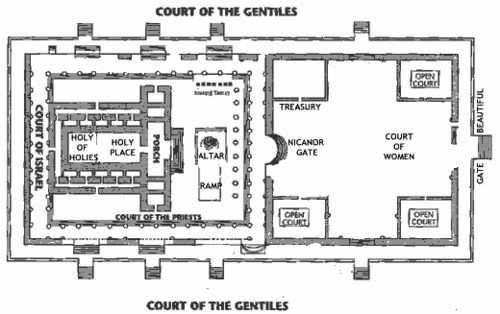
The next section of the temple was called the “Court of the Women” and was entered through the “Beautiful Gate”. This gate was guarded to ensure that only ritually pure Jewish men and women could enter this part of the temple. Archaeologist have found two inscriptions, called the Soreg inscriptions, which were placed outside this gate warning Gentiles that they were not allowed to go further. Josephus wrote that,
“The center of the structure was the tallest, with the front wall being built with beams which sat upon interlocking pillars. Highly glossed stones made up this wall, so finely polished that those who looked upon it for the first time marveled at it in amazement. This was the description of the first structure. Located within it, and nearby, were steps which led up to the second structure, which was surrounded by a stone wall used as a barrier, engraved with an inscription not allowing foreigners to enter into it under the penalty of death.” (in Antiquities of the Jews)
We can also see evidence of this wall of division between the Jews and the Gentiles in the words of the apostle Paul who wrote to the Ephesians that,
Wherefore remember, that ye being in time past Gentiles in the flesh…Christ, being aliens from the commonwealth of Israel, and strangers from the covenants of promise…But now in Christ Jesus ye who sometimes were far off are made nigh by the blood of Christ. For he is our peace, who hath made both one, and hath broken down the middle wall of partition between us.” (Ephesians 2:11-14)
Inside the Court of the Women were several different chambers; chambers for storing wood, oil and wine used in the temple, the chamber of the leper where lepers went to be purified, the treasury of the temple (which is where the widow would have given her last mite) and the chamber of Nazarites, where Nazarite vows were made. The Court of the Women also had large balconies surrounding it where Rabbis often taught. Whenever Jesus taught in the temple he would have taught in the Court of the Women, meaning that both men and women would have been able to hear his teachings.
The next part of the temple was the inner court, where the priests performed the sacrifices. This court was entered through the Niancor Gate which had huge sweeping steps. Both men and women were allowed to climb these steps and present their sacrifices, but only Jewish men were allowed to go beyond this point. The altar on which they performed sacrifices was a huge a ramp which allowed the blood to run down into collections vessels. They also over saw the fires for the burnt offerings.
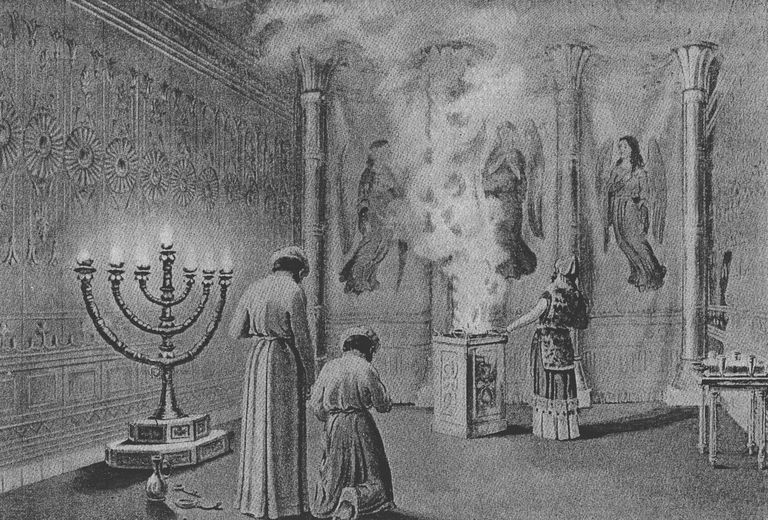
The last part of the temple was the actual temple building, known as the Holy Place. This was a huge rectangular building which only the priests could enter. Inside the Holy Place was the table for shewbread, the menorah, the sacred vessels of the temple, and the altar for burning incense. The priests entered into the Holy Place every day to burn incense, light the menorah and, on the Sabbath day, replace the bread on the table of shewbread. Yet they did not go into the inner most part of the temple, the Holy of Holies, where the symbols representing God– the arc of the covenant and the mercy seat– were (or in Jesus day were suppose to be). The Holy of Holies was separated from the Holy Place by a veil and the High Priest only went inside of it once a year, on the day of atonement. It was this veil which was “rent in twain from the top to the bottom” (Mark 15:38) when Jesus died, a beautiful symbol showing that now– after the great and last sacrifice of the son of God– the way to God was opened.
5) It was Destroyed by the Romans but Jews Believe it will be Rebuilt
Only 40 years after Jesus’s death the temple was destroyed by the Romans. In 66 BC, during the 12th year of the reign of Nero, the Jews staged a massive revolt against the Romans, and took control of Jerusalem even ousting the Roman leaders of Judea, Agrippa and his sister Bernice, who fled. Jewish rebels kept control of the city for several years, winning battles against the Romans, until in 70 BC the Romans besieged Jerusalem. The siege started right before Passover, when the city was filled to the brim with people visiting from all over Judea. The siege lasted four months and ended in a bloody battle between the Jews and the Romans. Josephus estimated that 1.1 million Jews were killed during the siege and that 97,000 Jews were taken captive by the Romans after their defeat.
During the battle for Jerusalem huge fires swept over parts of the city, including in the temple. These fires melted the gold and silver in the temple. After the siege was over, Roman soldiers tore the temple apart stone by stone in an attempt to get at the melted gold and silver. Today, all the remains of the once great temple is a portion of the western wall, sometimes called the “Wailing Wall”. This site is is sacred to modern Jews because it is all they have left of the temple, which is so central to their religion. Jews believe that one day the temple–the third temple– will be rebuilt in Jerusalem. Yet without access to the foundation stone (currently within the Dome of the Rock) the temple can not be rebuilt, and this is one of the main tensions between Muslims and Jews in the Holy Land.
It was Central to Jesus Christ’s Ministry
Understanding the temple in Jerusalem is central to understanding the life and ministry of Jesus Christ. From the time that he was twelve years old and his parents found him (probably in the Court of the Women) teaching and learning with the Rabbis to the day of his death when the veil of the temple split in two the temple was the focal point around which is ministry turned. It was his house, in which everything– from it’s construction, its ceremonies and its symbols– were designed to bear testimony of Him and his divine mission. When we learn about the temple and its symbols we are learning more about Jesus Christ, who He is and his role as our Savior and Redeemer.

